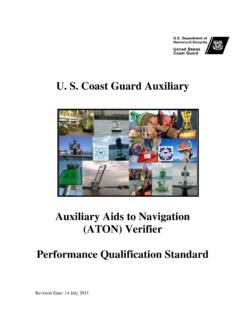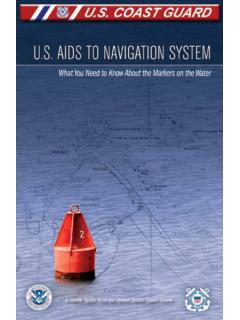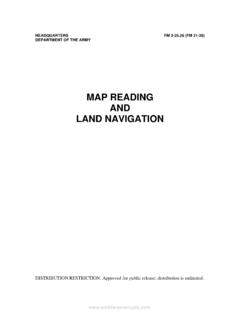Transcription of GNSS, INERTIAL, AND MULTISENSOR INTEGRATED …
1 I PRINCIPLES OFI GNSS, inertial , AND MULTISENSOR INTEGRATED navigation SYSTEMS BY PAUL D. GROVES On-line Appendix C Historical navigation Systems 6 April 2008 VLF.
2 19 April 2008 Decca. 20 April 2008 Loran. 5 May 2008 Introduction, From navigation aids to navigation Systems, Transit and Tsikada, Other Radio navigation Systems. 10 May 2008 Corrections and extra figures. 25 January 2009 Minor additions and changes to radio navigation systems. 8 February 2009 inertial navigation and Attitude Determination. 13 February 2009 Radio direction finding. 2008-9. Paul D. Groves All comments welcome. Contact the author at (remove capitals) Contents From navigation aids to navigation Systems 1 Very Low Frequency navigation 2 Omega 3 RSDN-20/ Alpha 4 VLF Communications 4 DELRAC 4 Decca Navigator system 4 Signals
3 5 Accuracy 6 DECTRA and DELRAC 6 Loran 6 Loran-A 6 Loran-B 7 Loran-C and Cytac 7 Loran-D and Pulse-8 7 Skywave-synchronized Loran 7 Transit and Tsikada 8 Transit 8 Tsikada 8 Doppler Positioning 8 Other Radio navigation Systems 9 Consol 9 Cyclan 10 Direction
4 Finding 10 Gee 10 Geostar and Locstar 11 ii Microwave Landing system 11 Navaglobe and Navarho 11 Radio Mailles 12 Radio-range and Two-course Beacons 12 Radux 12 Rebecca-Eureka and Shoran 13 Starfix 13 inertial navigation and Attitude Determination 13 Gyrocompass 13 Directional Gyro 14 Vertical Reference 14 Early inertial navigation Systems 15
5 Stellar- inertial navigation 15 References 15 Additional Acronyms 17 1 O N L I N E A P P E N D I X C Historical navigation Systems There are three reasons for adding a historical appendix to a book on contemporary navigation systems [0]. The first is simply completeness, the second is to put contemporary systems in context, helping to draw parallels between the different technologies, while the final reason is that some of the techniques used in past systems might be applicable in future systems.
6 The focus of this appendix is limited to electronic navigation systems. For older navigation techniques, the reader is directed to [1]. As well as obsolete systems, this appendix also includes navigation systems which are still operational, but have a limited user base and may be discontinued within the next few years; they are not covered in [0]. Section discusses the general evolution of navigation technology over the decades since World War II from aids to a human navigator to systems providing a complete navigation solution.
7 The remaining sections then describe a selection of obsolete and obsolescent navigation technologies. Section covers very low frequency (VLF) navigation systems, including Omega. Section describes the Decca Navigator system and its offshoots, while Section covers the legacy versions of Loran. Section describes the original satellite navigation systems, Transit and Tsikada. Section then summarizes the main features of a number of other radio navigation systems, both terrestrial and satellite. Lastly, Section discusses early inertial navigation technology.
8 From navigation aids to navigation systems Like any technology, the performance of electronic navigation systems has improved over the decades, while cost, size, mass and power consumption have dropped. Improvements have been both evolutionary, retaining backwards compatibility, and revolutionary, requiring new equipment to replace old. However, a key trend has been once of increasing automation. navigation of a ship or aircraft was originally performed by a human, known as a navigator. He determined the host vehicle s position from landmarks, by observing the stars and using dead-reckoning sensors, such as a ship s log or airspeed indicator, combined with a magnetic compass [1].
9 Radio signals were first used simply as electronic landmarks. The navigator determined the direction of the transmitter by rotating the receiver s antenna (either physically or electronically) and identified it by its frequency and/or a Morse call sign or program content. These transmitters were known as navigation aids or aids to navigation as they helped the human navigator to determine position. During World War II, a host of new navigation technologies were developed by a range of countries. As they needed to be brought into operation quickly, they were crude and often tailored to particular applications.
10 Use of these systems required listening out for Morse codes or observing traces on oscilloscopes. Following the war and through the 1950s, these technologies were improved and standardized across countries. A suite of systems: Decca, DME, Lorans A and C and VOR, some of which are still in operation, took over. These provided navigators with range, bearing or range difference measurements directly. For the hyperbolic systems, users were supplied with maps on which LOPs were printed, enabling them to determine position relatively easily from the measurements output by the user equipment.




